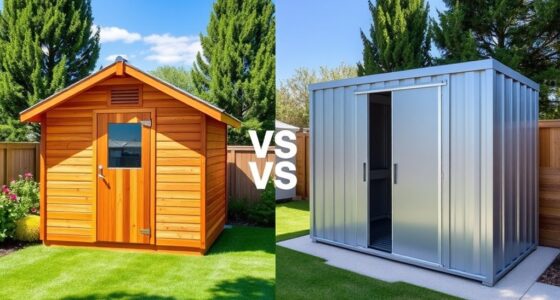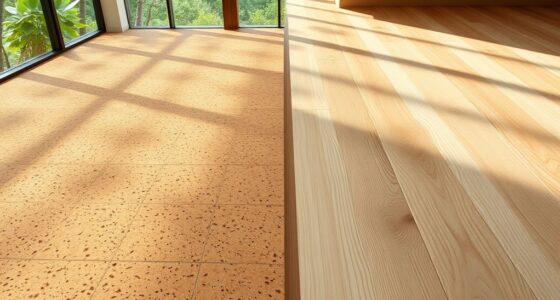To make the biggest impact with insulation upgrades, focus on your attic and walls first. These areas are key places where heat escapes or enters, so adding insulation can considerably lower your energy bills and improve comfort. Don’t forget floors and basements, especially if you have crawl spaces or slabs. Proper air sealing boosts overall efficiency. Keep exploring to discover which upgrades will give your home the best return.
Key Takeaways
- Upgrading attic and ceiling insulation significantly reduces heat loss and improves overall energy efficiency.
- Insulating walls minimizes drafts, uneven temperatures, and lowers heating and cooling costs.
- Floor and basement insulation enhance comfort, prevent moisture issues, and reduce heat transfer through the foundation.
- Air sealing around windows, doors, and vents maximizes insulation effectiveness and prevents drafts.
- Targeting under-insulated areas during renovations yields high energy savings and long-term cost benefits.

Upgrading your insulation is one of the most effective ways to improve your home’s energy efficiency and comfort. When you focus on areas like ceilings, walls, floors, and basements, you make a significant impact on how well your home retains heat and coolness. Ceiling insulation is particularly important because it reduces heat loss through the roof, which is a common escape point for warm or cool air. By insulating your ceilings properly, you can lower your energy bills and stay comfortable year-round. Wall insulation also plays an essential role in maintaining a steady indoor temperature. If your walls are under-insulated, you’ll notice drafts, uneven temperatures, and higher energy costs. Adding insulation to your walls helps create a consistent indoor climate, making your home more comfortable and reducing strain on your heating and cooling systems. Studies show that upgrading wall insulation can lead to energy savings of up to 45%, further emphasizing its importance in overall home efficiency.
Proper insulation in ceilings and walls boosts energy efficiency and indoor comfort year-round
Floor insulation is often overlooked but can deliver substantial benefits, especially if your home has crawl spaces or is built on a slab. Proper floor insulation cuts down on heat loss through the floors, making your living space warmer in winter and cooler in summer. If you have a basement, insulating it helps keep the space warmer in cold climates and reduces moisture problems, which can prevent mold and structural issues. In addition to these specific areas, air sealing is essential for maximizing insulation performance. Sealing leaks around windows, doors, and vents prevents drafts and air leaks that can undermine your insulation efforts. When air leaks are minimized, your insulation works more efficiently, resulting in better temperature regulation and energy savings.
Building types like residential homes, commercial buildings, schools, and industrial facilities benefit greatly from insulation upgrades. Many existing structures are under-insulated, meaning you have a real opportunity to save energy—potentially between 10% and 45% in homes—while reducing emissions. On a broader scale, upgrading insulation can lead to significant reductions in carbon emissions, comparable to operating millions of wind turbines for a year. Besides environmental benefits, these upgrades offer financial advantages. While the initial investment might seem high, tax incentives and long-term savings on energy bills make it a worthwhile expense, often with a favorable return on investment.
Over time, insulation performance degrades minimally, and proper maintenance can extend its effectiveness well beyond the typical 20-year lifespan. Damage from pests, fungi, or fire can reduce insulation’s efficiency, but upgrades during renovations can restore or improve its performance. Insulation also contributes to your comfort by regulating indoor temperatures, reducing external noise, and controlling humidity. It can even help keep pests out and improve overall indoor air quality. In brief, focusing on ceiling, wall, floor, and basement insulation—along with air sealing—delivers the most noticeable improvements in energy efficiency, comfort, and environmental impact for your home.
Frequently Asked Questions
How Do I Determine the Best Insulation Type for My Home?
To choose the best insulation for your home, first assess your climate—hot or cold—and your moisture levels. Consider your space constraints and existing infrastructure, especially if retrofitting. Think about your budget, ease of installation, and desired energy efficiency. Finally, evaluate durability and maintenance needs. By matching these factors to insulation types like spray foam, fiberglass, or foam board, you’ll find the most effective solution tailored to your home’s unique requirements.
What Is the Typical Lifespan of Different Insulation Materials?
While some insulation types last decades, others fade sooner, shaping your choices. Fiberglass and mineral wool can last up to 100 years with proper care, offering durability against pests and moisture. Spray foam varies from 40 to 100 years based on type, while cellulose usually lasts 20 to 30 years before needing replacement. Regular inspections guarantee you maximize lifespan, saving you money and maintaining energy efficiency over time.
Are There Specific Upgrades Recommended for Older Homes?
You should focus on upgrading your attic insulation first, since older homes often lack proper coverage, leading to significant heat loss. Adding blown-in cellulose or spray foam can seal leaks and improve energy efficiency. Also, insulate basement and crawl spaces to prevent drafts and moisture problems. These upgrades deliver the most noticeable comfort and savings, making your home more energy-efficient and reducing utility bills over time.
How Much Can Insulation Upgrades Reduce Energy Bills?
Imagine your home as a cozy fortress, guarding you from the harsh outside world. When you upgrade insulation, you’re sealing its walls tighter, stopping energy leaks like an invisible shield. You could cut your energy bills by 15% to 45%, saving around $200–$400 annually. Over time, this investment pays off, making your home more comfortable and your wallet happier, especially in colder climates where the fortress needs extra armor.
What Are the Safety Considerations During Insulation Installation?
When installing insulation, safety should be your top priority. You need to wear PPE like goggles, gloves, and a dust mask to protect against fibers and irritants. Turn off electrical power before working near wiring, and guarantee good ventilation to avoid fumes. Keep your workspace clean, store insulation properly, and use proper lifting techniques. Taking these precautions helps prevent injuries and health issues during installation.
Conclusion
Upgrading your insulation truly makes the biggest difference in areas like attics and exterior walls, where heat loss is most significant. Think of insulation as a cozy blanket—adding it where it’s thinnest keeps your home warmer and reduces energy bills. If you visualize your home with thicker insulation in these key spots, you’ll see firsthand how it traps heat effectively. Prioritize these upgrades for a noticeable, cost-efficient improvement in comfort and energy savings.









